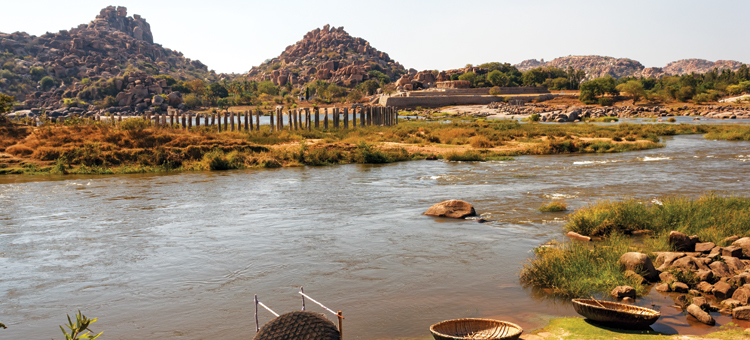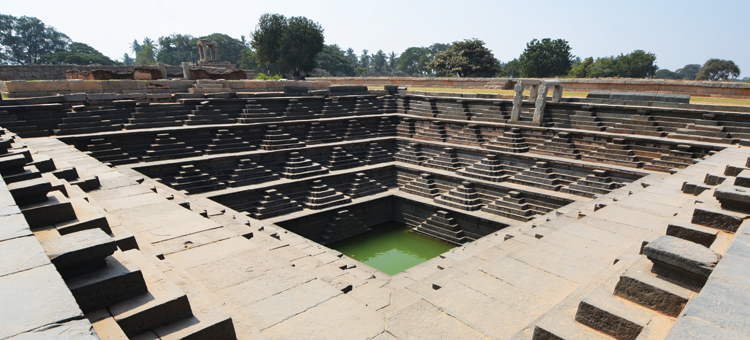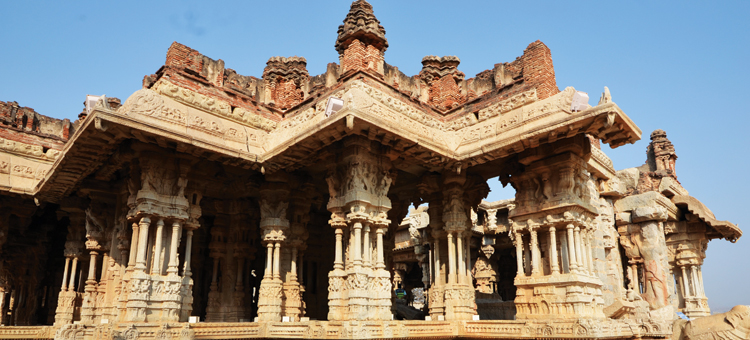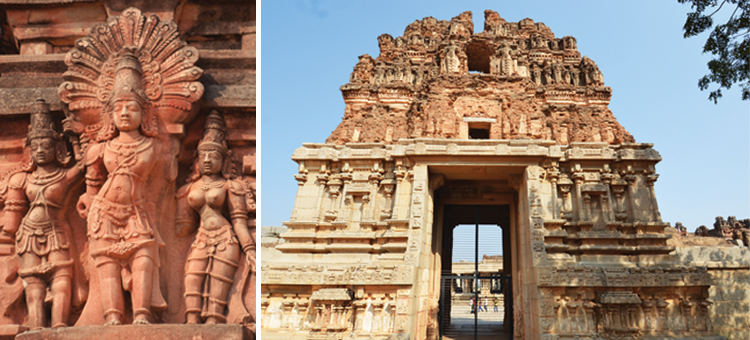Hampi: The signboard on the left read, ‘Hampi – 20 km.’ I had just boarded an auto rickshaw after an overnight road journey from Mumbai to Hospet, and was so relieved to see Hampi drawing closer.
“Madam where are you from?” I had found myself a chatty rickshaw driver. “Mumbai” “Local stay, travel, sight-seeing anything needed?” “Houdu. Yella chennage book maadide” (Yes, the booking’s done. All well.)
My auto driver was happy that I replied in Kannada, and that was an ice-breaker. For the next half an hour, as I chatted with him, I got all the advice that a solo woman traveller in Hampi could put to good use. Including the best place where one could rent out a bike by the day and what time the last boat ride is.
The erstwhile capital of the Vijayanagara empire and now an UNESCO World Heritage Site is a dream-world made of massive boulders, huge monoliths and breathtaking temple ruins. A traveller cannot but feel awe and curiosity for all that the town offers
We passed farmers on large oxcarts, some transporting harvested grains, and others carrying groups of people to work in the fields. Our road meandered through lush green paddy fields with coconut palms swaying in the distant periphery. And soon those farms morphed into a landscape that looked as though it had rained giant boulders. Boulders large enough to dwarf coconut trees. They appeared perfectly balanced, perched on top of each other like lagori that slingshot stone-game I remember playing at school. Seeing the morning sun gleaming on the boulders made for a surreal sight.
As we approached Hampi, the last half-a-kilometre that we drove on was a granite stone-paved stretch, which I’m told the kings of the Vijayanagara empire used in the early 1500s. I was feeling like royalty already! I have been in awe of Hampi since childhood. Hampi is the erstwhile capital of the Vijayanagara empire and an UNESCO World Heritage Site today, which makes it a ‘must see’ for people who’re interested in touring India for its temple architecture. It’s the place I had seen in travelogues on Bharat Ek Khoj and Discovery channel.
And exploring it with a backpack was the thing I had always wanted to do. But this time, I just had three days in between work projects. Life’s too short for the bucket list, so I took the plunge anyway and reached Hampi.
DAY ONE
To get a fairly good accommodation, one has to cross the Tungabhadra river. Since hotels and the Old Hampi city are on opposite sides of the river, one has to cross the river once or twice a day. This supports an ecosystem of not only the local hotels, but also over-friendly guides and boat owners.
The circular boats here are called Coracles. Being brought into use by the locals of Hampi over 500 years ago, the modern-day Coracle of today looks exactly the same as the older one except for that today it’s made using modern materials. The leather on the outside now has a thick coating of plastic, making it waterproof. So it’s not the regular boat, and offers a novel experience taking a ferry ride on it.
After getting on the other side of the river, I rented a bike and went up to the guest house. I was put up at ‘Bobby One Love’ (yes, the name sounded cheesy, but a friend who had been there recommended that the place is superb). And the place lived up to it. Over the next two days, I ended up having the best North Indian food I have ever ordered in Karnataka. For people more adventurous in taste, there were Russian and Israeli preparations on the menu as well.
The morning was spent unpacking and having a refreshing brunch. Then I devoted the afternoon to a little relaxation. It’s the thing that happens as an automatic result of being in the midst of so much fresh air, greenery and blue sky. Felt like time has slowed down to the pace of a caterpillar inching its way on a lush green leaf.
For second half of day one, I went on an expedition around the village. Seeing how locals live there, sampling some teas in the local restaurants and exploring shopping. In the evening, I took a ride up to Sanapur Lake, which is Hampi’s perennial waterbody. It was simply breathtaking. Ferrying every tourist, there was only one Coracle in use there, being rowed by a guy named Moses. Moses was quite resourceful and I was glad to have made the trip there. He took us to a hillock on the side of the lake, which offered some of the best views of the giant boulder hills. I shot some photos of the hills and then came back to the guest house to call it a day early.
However, on reaching the guest house, I was told that the sunset looks beautiful from a hillock nearby. A group from the guest house was heading there. I thought it was a great idea to join them. A 20-minute trek later, we were on the top of a 300 ft hill, made of giant boulders. The view from the top of the hill was to die for! (quite literally, if you miss a step). Watching the sun set perched on top of a boulder wasn’t really on my bucket list, but a welcome addition!
DAY TWO
On the second day, I was joined by my friend Deepti from Bengaluru. Deepti, who works as a designer there, has been my partner in crime for many such photography expeditions. We hired Kumar, a tourist guide who also drove us around the places of interest. He told us that the best thing to do was to start early since we wanted to skip the touristy crowds, while taking photographs of the temples. He first took us to Vijaya Vitthala Temple, which is to the north east of Hampi, dedicated to Lord Vishnu. My interest in it was defintely not religious, so I’m not going into the stories we got to hear about the temple.
This temple complex is one of Hampi’s main attractions and I could see why. It’s simply so grand and huge that Deepti and I felt like we were walking in this dream-world made of boulders, monoliths and temple ruins. The Vijaya Vitthala Temple complex has three large gateway towers, pavilions, several hallways and an intricately carved temple in the centre.
The front of the temple has a stone chariot, and it is counted among the three most famous ones in India (the other two being Mahabalipuram and Konark). Inside the main temple we could see a balustrade and a series of pillars. The main temple hall converges with something called a Mahamandapam (I’m not one for retaining a lot of trivia but this is me getting a dose of architecture). So this temple has 40 main pillars, each surrounded by seven small pillars, which produce sound. We saw our guide patting the pillars, and true enough each of them produced a distinct note. I was fascinated by how a sculptor could imagine creating music out of stone! The entire place took us about two and a half hours to tour, since we wanted the best vantage points, the perfect angles, which meant a lot of walking around. The December sun is milder, so it did not tire us out too much.
“Hey, there’s a tender coconut stall at the exit gate!”, Deepti observed, and we got ourselves a refreshing drink. One of the perks of being in a place like Hampi, is that there are tender cococnut stalls at most of the places of interest. So you’re just one healthy drink away from being totally refreshed. Second on our list was the Hazara Rama Temple. The sculptures of Ramayana are so beautifully carved on its walls that one couldn’t help but appreciate its craftsmanship.
“Look there!” Kumar said as we found a derelict lion statue. “Oh that’s beautiful! Did you see the level of detail in it?” Of course we did. The devil is in the details.
It’s not like we needed an excuse to click pictures. But yes, the place had a lot of exquisitely beautiful sculptures, so it gave us all the more reason to capture them on camera. If you are not a photography enthusiast, you’d go there for the sheer beauty of the Alice in Wonderland-like combination of derelict ancient temple ruins, hills of giant boulders and green paddy fields.
Kumar reminded us that it was almost 2 pm, and since he was going to anyway stop by for lunch at a local restaurant, we said, “we want South Indian food.” We found a place that served us the most authentic, steaming hot dosa, idli sambhar and garlic chutney that I’ve tasted other than in Bengaluru. With renewed energy we started out exploring the rest of this enchanting temple town.
Next, we went to the Royal Enclosure. Legend has it that the kings used to host a 10-day cultural program every year during Dussera, and this was the hub of all cultural activities. The enclosure has three entrances and massive stone doorways on each entrance. I am told there were 43 buildings within this enclousre, at some point in time. From here, we went to the Octagonal bath, the Elephant stables, the Sasivekalu Ganesha Temple, the Lakshmi Narasimha Temple and concluded with the Virupaksha Temple.
Believed to be the oldest functioning temple in India, Sri Virupaksha Temple is a seventh-century Hindu place of worship dedicated to Lord Virupaksha, an incarnation of Lord Shiva. The temple is also considered as one of the most significant religious places to visit in Hampi and attracts a huge number of pilgrims from all over India.
Most people visit Hampi because they want to see one of the famous World Heritage Sites in India. But I’d go there for the experience of being in an enchanting town, savouring authentic local cuisine and being close to nature.
There are many hidden places around Hampi, such as Matanga Hill and Anegundi that are worth visiting. There are ancient monuments grand enough to fascinate the urban traveller. It is easy to get lost in Hampi’s immense grandeur, touring Dravidian-style structures that will leave you spellbound. We spent days just wandering around the ancient city, re-discovering bits of heritage, finding traces of an ancient civilization in every nook and corner.
At the end of the day we went across to Sanapur Lake yet again to catch a glimpse of the sunset. Moses ferried us across the lake on a Coracle and showed us a spot from where we could get a panoramic view of the town below. It was one of those chance findings that we never imagined we’d have.
We had to head back to Hospet the same evening. I was travelling to Mumbai and Deepti to Bengaluru by train. On the way back I met Daniel Tourgeman, a musician from Israel, who lives in Berlin, Germany. Daniel and I connected over music while sharing experiences of our favourite music bands. And then, we swapped stories of our stay in Hampi. And I got a tourist’s perspective on it.
She had resided in a really simple homestay next to the lake for a week. She recommended Shanti Guest House for a view of the Tungabhadra river and green paddy fields, which not many people may have chanced upon. And she had tried bouldering. Apparently, Hampi is one of the largest bouldering districts in Asia, where people from across the world come to learn bouldering.
All in all, I came away with a feeling of awe and curiosity for all that Hampi, the ancient town offered. It has something for every kind of traveller: There are ancient monuments, there’s adventure sport and there’s the unhurried pace of rural life. There’s so much more that I wanted to explore. I’m convinced that I’m going back there soon as I get that long weekend break in the next few months!










Awesome read!
I am surely visiting there soon.
Thanks for the details.